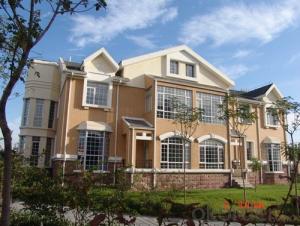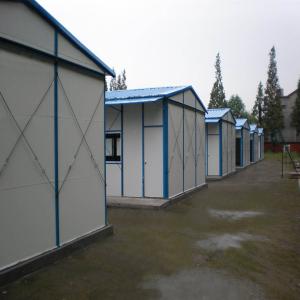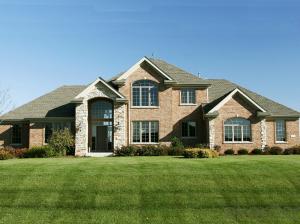Light gauge steel new type house
- Loading Port:
- China Main Port
- Payment Terms:
- TT OR LC
- Min Order Qty:
- -
- Supply Capability:
- -
OKorder Service Pledge
Quality Product, Order Online Tracking, Timely Delivery
OKorder Financial Service
Credit Rating, Credit Services, Credit Purchasing
You Might Also Like
The adavantages of the light gauge steel villa:
1. Better thermal insulation
The advanced exterior overall thermal insulation meets the updated state energy-saving standards for buildings. It refrains from the cold and thermal bridges phenomenon, and keeps buildings away from damages such as dampness, distortion, mildew and corrosion.
The unique heat reflection and ventilation layer design can make better insulation effects. Temperature can be reduced by five to eight degrees. ( In my opinion, this advantage is very suitable for the climatic condition of Middle East )
2. Seismic and Wind Resistance
Withstand the shock of 9 on the Richter scale. The dense light gauge steel and column are connected in flexible method with screws and bolts, which can abosorb the energy of eathquake. There are fittings between foundation and wall, which are resistant to pull out and shear. The total weight of the house is light, which is only 1/6 of the conventional concrete houses. Therefore it has better anti-seismic performance.
Can endure typhoon of 12 levels
There are special fittings among roof, floor, wall and foundation. The strong connection can help resist typhoon of 12 levels.
3. Roof Load-bearing and Fireproof
The structure can be designed according to climate requirements.
Wall and floor slab use special technology which can meet 3h refractory limit.
4. Sound insulation
Improved technology on sound insulation and shock absorption meet the state building standards for sound insulation. Special methods are performed, especially towards the audio frequency ranging from 250-1000Hz which is the most sensitive to ears, in order to create a quiet and comfortable living environment.
5. Moisture-proof and Ventilation
There is a gap between wall and roof truss, so the air can flow inside.
There is one-way ventilation layer in the composite wall, which is able to make the wall "breath". This means moisture can be reduced inside the door.
6. Durable (90 years structure safty guarantee)
Special coating technology enables the structural materials to have the self-restoration function to prevent rust and corrosion.
Envelope materials using new light weight building materials to achieve fire resistant, anti-corrosion and anto-moth.
7. Energy Efficient and Enviromental Protection
Energy Saving: 65-90 energy redution.
Water Saving: The dry construction consumes 10% of water used in traditional constrution.
Land Saving: The inside usable area increases 10%
Environment Protection: Pollution-free construction system.
- Q:Can container houses be built with a contemporary gym or fitness area?
- Yes, container houses can certainly be built with a contemporary gym or fitness area. Container houses are versatile and can be customized to meet specific needs and preferences. With careful planning and design, a container house can be modified to include a dedicated space for a gym or fitness area. Container houses offer flexibility in terms of layout and design. They can be easily expanded or modified to accommodate additional rooms or sections. By utilizing multiple containers or modifying the existing structure, it is possible to create a separate area specifically for a gym or fitness space. When designing a container house with a gym or fitness area, certain factors need to be considered. Adequate space should be allocated for various gym equipment and exercises. Proper ventilation and lighting should be incorporated to create a comfortable and functional workout environment. Additionally, insulation and soundproofing measures may be necessary to ensure privacy and minimize noise disturbance. With the right planning and professional guidance, container houses can be transformed into contemporary living spaces with a dedicated gym or fitness area. This not only adds value and functionality to the house but also promotes a healthy and active lifestyle for its occupants.
- Q:What are the maintenance requirements for container houses?
- The maintenance requirements for container houses typically include regular cleaning and inspection of the structure, ensuring proper insulation and ventilation, addressing any rust or corrosion issues, and maintaining the plumbing and electrical systems. Additionally, maintaining the exterior paint or coating, as well as monitoring and addressing any potential pest infestations, are also important for the upkeep of container houses.
- Q:Can container houses be designed with a modern or contemporary aesthetic?
- Yes, container houses can definitely be designed with a modern or contemporary aesthetic. In fact, many architects and designers have embraced the use of shipping containers as a sustainable and affordable building material, while also incorporating sleek and stylish designs. One of the advantages of using container houses for modern or contemporary designs is their clean and industrial look. The metal structure of the containers, with their straight lines and geometric shapes, can lend themselves well to a modern aesthetic. Additionally, the uniformity of the containers allows for modular design, which can be easily customized to create a contemporary look. Designers often incorporate large windows, open floor plans, and minimalist interiors to enhance the modern feel of container houses. This allows for abundant natural light, an airy atmosphere, and a seamless integration between indoor and outdoor spaces. The use of high-quality finishes, such as wood or polished concrete, can further elevate the overall contemporary aesthetic of the container house. Moreover, container houses can be creatively stacked or arranged to create unique and visually striking designs. Architects have experimented with cantilevered sections, rooftop gardens, and even multi-story container structures, all of which contribute to a modern and cutting-edge appearance. Ultimately, container houses offer a versatile canvas for modern or contemporary designs. With the right architectural vision and attention to detail, these structures can be transformed into stylish and visually appealing homes that seamlessly blend sustainability and aesthetics.
- Q:Can container houses be designed with a fireplace?
- Yes, container houses can be designed with a fireplace. The design may require proper insulation and ventilation to ensure safety and efficient operation of the fireplace within the container structure.
- Q:What are the disadvantages of living in a container house?
- Living in a container house has its fair share of drawbacks. One primary disadvantage is the limited space within the container. Originally designed for shipping, containers are typically small and cramped, posing a challenge for individuals or families in need of more living area. This can make furniture arrangement and storage difficult, requiring creative use of available space. Furthermore, container houses may lack proper insulation, resulting in extreme temperatures indoors. In hot summer months, the containers can become unbearably hot, necessitating additional cooling systems. Conversely, during colder seasons, the lack of insulation makes it challenging to maintain a comfortable indoor temperature, requiring extra heating sources. Another drawback is the limited natural light that enters the container. Small windows make the space feel dark and gloomy. This lack of natural light can negatively affect mood and productivity, often requiring artificial lighting throughout the day. Privacy can also be a concern in container houses. Due to their design, containers offer limited soundproofing capabilities, allowing noise from outside or neighboring containers to easily penetrate the living space. This lack of privacy can be a significant drawback for those who value a peaceful living environment. Moreover, obtaining permits and meeting building regulations can be a more arduous task for container houses. Areas often have strict zoning laws and building codes that may not align easily with container housing. This can lead to a longer and more complex process to gain necessary approvals, potentially resulting in delays and higher costs. Lastly, the resale value of container houses may be lower compared to traditional houses. As container houses are still relatively new and unconventional, there may be less demand from potential buyers. This can make it challenging to recoup the initial investment or make a profit if the property is sold in the future. In conclusion, container houses offer unique and environmentally friendly living options, but they come with their fair share of drawbacks, including limited space, insulation issues, lack of natural light, privacy concerns, challenges in obtaining permits, and potentially lower resale value. It is crucial to carefully consider these disadvantages before deciding to live in a container house.
- Q:Can container houses be built with a small garden or outdoor space?
- Certainly, it is feasible to construct container houses with a compact garden or outdoor area. The versatility of container houses allows for an array of design possibilities, including the incorporation of outdoor spaces. One option commonly utilized is the creation of a rooftop garden atop the container house. This approach not only optimizes space utilization but also presents a lush and tranquil environment for inhabitants. Depending on the available area and the preferences of the homeowner, rooftop gardens can consist of planters, seating arrangements, and even small water features like ponds or fountains. Another alternative is the inclusion of a small garden or patio adjoining the container house. This can be achieved by preserving a portion of land during the construction process or by employing additional containers to establish a separate outdoor space. The garden can be adorned with plants, flowers, and even a small vegetable patch, granting residents the opportunity to relish nature and cultivate fresh produce in their own backyard. Furthermore, container houses can be modified to feature balconies or terraces, providing outdoor areas on distinct levels. These spaces can be utilized for relaxation, barbecuing, or simply appreciating the picturesque surroundings. On the whole, with meticulous planning and design, container houses can certainly accommodate a diminutive garden or outdoor area. This allows inhabitants to establish a connection with nature and enjoy the advantages of outdoor living, notwithstanding the compact and eco-friendly nature of their container house.
- Q:Can container houses be designed with a modular layout?
- Yes, container houses can definitely be designed with a modular layout. The modular design approach allows for easy assembly and customization of container homes by combining multiple shipping containers to create larger living spaces. This flexibility in layout and configuration makes modular container houses a popular choice for those seeking efficient and sustainable housing solutions.
- Q:Can container houses be expanded?
- Yes, container houses can be expanded. One of the advantages of using shipping containers for housing is their modular nature, which makes it relatively easy to add additional containers to increase living space. These containers can be stacked or joined together to create multi-level or larger living areas. Additionally, container houses can also be expanded horizontally by adding new containers next to the existing ones. The flexibility of container homes allows for various expansion options, making them a versatile and convenient choice for those looking to increase their living space.
- Q:Can container houses be designed to have a laundry room?
- Yes, container houses can definitely be designed to have a laundry room. The interior layout and design of container houses can be customized to accommodate various functional spaces, including a dedicated area for laundry. By strategically planning the placement of plumbing, electrical connections, and appliances within the container, it is entirely feasible to integrate a laundry room into the design.
- Q:Are container houses resistant to floods?
- Yes, container houses can be made resistant to floods by implementing proper design and construction techniques.
1. Manufacturer Overview |
|
|---|---|
| Location | |
| Year Established | |
| Annual Output Value | |
| Main Markets | |
| Company Certifications | |
2. Manufacturer Certificates |
|
|---|---|
| a) Certification Name | |
| Range | |
| Reference | |
| Validity Period | |
3. Manufacturer Capability |
|
|---|---|
| a)Trade Capacity | |
| Nearest Port | |
| Export Percentage | |
| No.of Employees in Trade Department | |
| Language Spoken: | |
| b)Factory Information | |
| Factory Size: | |
| No. of Production Lines | |
| Contract Manufacturing | |
| Product Price Range | |
Send your message to us
Light gauge steel new type house
- Loading Port:
- China Main Port
- Payment Terms:
- TT OR LC
- Min Order Qty:
- -
- Supply Capability:
- -
OKorder Service Pledge
Quality Product, Order Online Tracking, Timely Delivery
OKorder Financial Service
Credit Rating, Credit Services, Credit Purchasing
Similar products
New products
Hot products
Related keywords




























